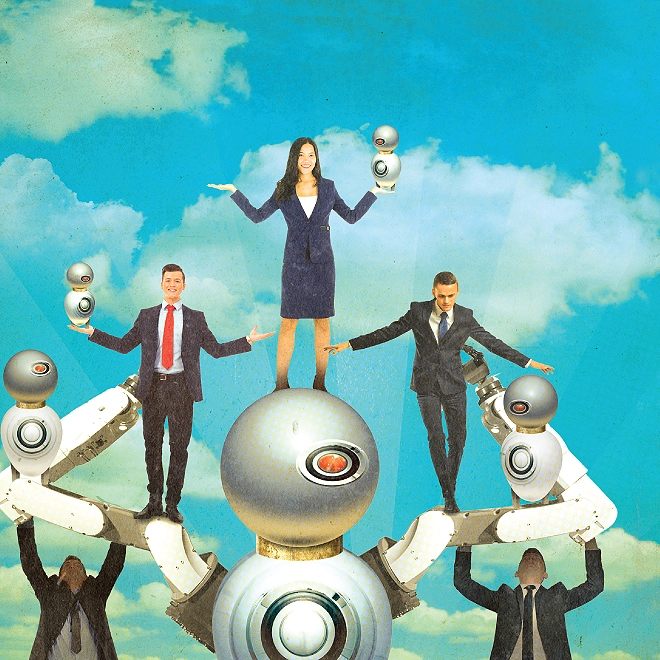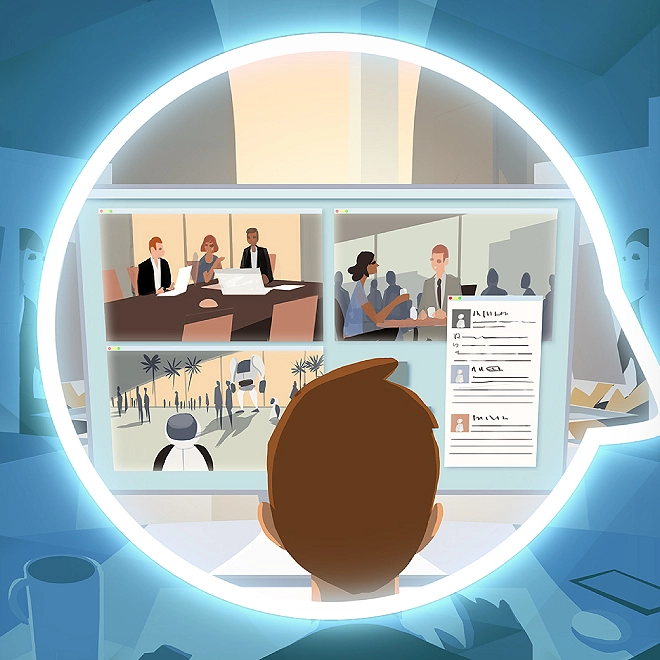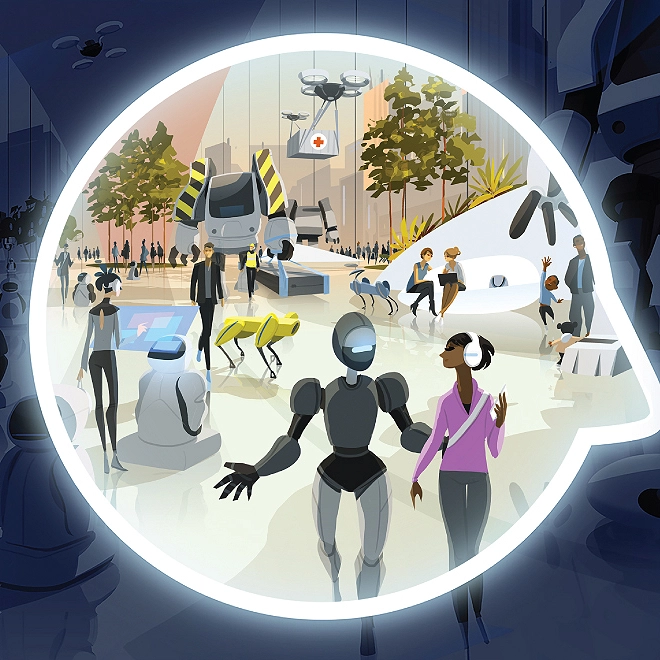Superteams
Putting AI in the group
“Superteams”—groups of people and intelligent machines working together to solve problems, gain insights, and create value—are the next step in AI’s continuing integration into the world of work.
2021 Global Human Capital Trends
Sign up to receive a copy of our new approach to Trends launching this winter
THE wait is over: artificial intelligence (AI) is here. And despite apocalyptic predictions about workers being replaced by intelligent machines, leading organizations are taking a new tack: actively searching for strategies to integrate AI into teams to produce transformative business results. These “superteams” hold the promise of enabling organizations to reinvent themselves to create new value and meaning, while giving workers the potential to reinvent their careers in ways that help increase their value to the organization and their own employability. For organizations that still view AI mainly as an automation tool to reduce costs, connecting their AI initiatives with their efforts to craft more effective teams is a first step toward enabling humans and machines to work together in new, more productive ways.
The Readiness Gap: Fifty-nine percent of organizations say the redesign of jobs to integrate AI technology is important or very important for their success over the next 12 to 18 months, but only 7 percent say they are very ready to address this trend.
Current drivers
After years of hype and speculation, AI has finally left the realm of science fiction to become a clear and present organizational priority. In our Global Human Capital Trends survey, 70 percent of respondents said that their organizations were exploring or using AI at some level. And in Deloitte’s 2020 global technology leadership study, more than 1300 CIOs and senior technology leaders said that analytics and cognitive will have the second-largest measurable impact on the organization in the next three years.1 And no wonder organizations are paying attention: AI is projected to add US$13 trillion to the global economy over the next decade.2
As AI enters the workforce, the critical question is not whether it will affect jobs, but how—a question that is prompting an increasing amount of discussion about AI’s role at work. For years, predictions have been grim, with headlines playing seemingly endless variations on “robots are coming for your job.”3

Yet cutting costs by eliminating jobs is not the only path available for AI. Organizations face a fundamental choice: whether to use AI solely to automate tasks formerly performed by people, or to use it to assist workers as well. The good news is that our survey respondents are reporting that they are leaning toward the latter. Only 12 percent of respondents said their organizations are primarily using AI to replace workers, while 60 percent said their organization was using AI to assist rather than to replace workers (figure 1). Furthermore, the majority of our respondents believed that the number of jobs would either stay the same or increase as a result of AI’s use (figure 2).

The bad news is that our data is showing some gaps in how organizations are using AI to assist and augment their workforce. One is that the way organizations report using AI to assist workers is limited, focusing more on increasing consistency and productivity than on increasing value. More than half of the organizations in our survey are using AI mainly to help improve consistency and quality, and about a quarter more are using it primarily to boost productivity. Only 16 percent of respondents say that their organizations are using AI primarily to assist workers in developing insights (figure 3).
The second gap is that organizations are not making enough investments in training: Only 17 percent of respondents said that their organizations are making “significant” investments in reskilling to support their AI strategy—which raises the question of how these organizations expect to prepare their workforce for the changes in their jobs that our respondents think AI will drive. Taken together, these results suggest that many organizations may have yet to think through the full implications of AI’s impact on the workforce.

Our 2020 perspective
How can organizations unlock AI’s potential to transform work and jobs in ways that generate value and net new jobs? We propose that to be able to do this effectively, organizations must find ways to thoroughly integrate AI into workplace teams. Integrating AI into teams is critical to creating value because teams are the fundamental unit in which most work is accomplished in today’s organizations. Our 2019 research revealed that 65 percent of organizations view the shift from functional hierarchies to team-centric and network-based organizational models as important or very important. Those whose organizations were already operating in teams were seeing the benefits, with 53 percent saying the transition resulted in a significant improvement in performance.4
Superteams through the years in Global Human Capital Trends
This year’s “Superteams” trend builds on two evolutions over the last decade: the rise of teams, and the growing adoption of artificial intelligence in the workplace. These evolutions, which are pivotal forces in the future of work, have set a stage on which organizations will thrive or risk being left behind in the face of unprecedented disruption.
As organizations became more digital over the past decade, they faced an imperative to redesign themselves to move faster, adapt more quickly, facilitate rapid learning, and embrace their workforces’ dynamic career needs. The result was a deconstruction and redesign of organizations into networks and ecosystems built for speed, agility, and adaptability, as we explored in our 2016 and 2017 reports. Last year, in “Organizational performance: It’s a team sport,” we discussed how the shift to teams is critical to business performance as well—with 74 percent of our respondents saying their transition to a team/network-based organization has resulted in improved performance.
Artificial intelligence adoption faced a similar trajectory: What was an early concept at the beginning of the decade evolved into an imperative for business performance. Our 2015 chapter on “Machines as talent” introduced the idea that machines could be collaborators, rather than competitors, in the workplace. Just two years later, AI and cognitive technologies had taken hold in the workforce, with 41 percent of our survey respondents saying they had fully implemented or made significant progress in adopting cognitive and AI and another 34 percent piloting programs. However, our 2017 report also revealed a critical gap. Despite the widespread adoption of these technologies, only 17 percent of respondents reported that they were ready to manage a workforce with people, robots, and AI working side by side—the lowest readiness level that had ever been reported in our Global Human Capital Trends surveys. Our call to action was clear: Organizations should expand their vision of the workforce and redesign jobs to accommodate tasks that can be automated and outsourced and the new role of human skills. This discussion culminated in last year’s “From jobs to superjobs,” in which we explored the emergence of “superjobs” that bring together technical and soft skills into integrated roles that combine parts of different traditional jobs, leveraging the productivity that can arise when people work with smart machines, data, and algorithms.
This year, the rise of teams and the adoption of artificial intelligence come together in our “superteams” discussion, which shows how putting AI onto teams can enable organizations and individuals to reinvent themselves and work together in new, more productive ways.
The concept of “superjobs” offers a clue into what integrating AI into teams could look like. As we wrote last year, superjobs combine work and responsibilities from multiple traditional jobs, using technology to broaden the scope of the work performed. For innovators that view AI as a means to transform work, superjobs combine what humans and machines do best to improve business outcomes.5 At one company that employs both humans and robots at its warehouse-distribution centers, for instance, the center manager’s role has evolved from simply overseeing shifts to determining when the people and the robots should hand off work to each other, which takes a different kind of technical and business expertise.6
“Superteams”—combinations of people and machines leveraging their complementary capabilities to solve problems, gain insights, and create value—extend this concept beyond the individual to the group. This framing builds on the work of Thomas Malone, the founding director of the MIT Center for Collective Intelligence, whose book, Superminds: The Surprising Power of People and Computers Thinking Together, explores how groups of humans and machines can work together to achieve new levels of intelligence.7 Malone summarizes his thinking on the topic with the phrase “from humans in the loop to computers in the group”: creating teams where computers and people each use their complementary strengths to achieve a common goal.8
Superjobs and superteams illustrate how the relationship between technology and people is evolving from a focus on automating work to replace workers, to augmenting workers with technology to create superjobs, to collaborating with technology to form superteams at the group level (figure 4). Our contention is that, as organizations progress further along this spectrum, the degree to which technology can transform organizational outputs increases. At the first stage, substitution, the new outputs allow for reduced costs and improved efficiency. At the second stage, augmentation, a greater degree of transformation drives greater value and expanded opportunities, as well as reducing costs and improving efficiency. And at the third stage, collaboration, a still greater degree of transformation enables the work and the outputs to take on more meaning for workers and customers—as well as driving greater gains in costs, efficiency, and value.9

We also believe that efforts focused on augmentation and collaboration can potentially free up much more workforce capacity than simply substituting intelligent machines for human workers, even though freeing up capacity may not be these efforts’ end goal. This is because effective augmentation and collaboration strategies use AI to reimagine the nature of the work rather than to continue doing the same old work, only with different actors.
Moving from a substitution mindset toward augmentation and collaboration will require reinvention at multiple levels, both by workers and by organizations. Figure 5 suggests some steps that can help drive this reinvention at each of the five levels that we consider essential to effective teaming.10 Common across all these steps is the concept of creating security through reinvention: Using the reinvention that AI drives to encourage individuals and organizations to grow in new directions that can make them more successful in the future of work.

Learning by example
Forward-thinking organizations across industries are showing how they are incorporating AI at each of the three levels of substitution, augmentation, and collaboration. Several utility companies, for instance, are exploring remote sensing, cloud, data analytics, and AI to fundamentally transform how infrastructure is managed. Remote sensing involves drones, helicopters, satellites, and various sensors to collect information on asset conditions and situational awareness. Compared to a manual infrastructure inspection process, remote sensing is much faster, more efficient, and data-rich. These massive loads of unstructured data require cloud and advanced data analytics for storage and curation. From there, AI is being deployed to initially augment humans in identifying defects.11 Over time, human involvement will be significantly reduced while accuracy and operational efficiency will climb. The future of infrastructure management will be delivered by robots in the field, data analytics in the cloud, and AI embedded in the process. This will allow companies to refocus people on making better decisions faster.
Other AI applications demonstrate the value that can arise from augmentation, which combines AI and humans’ complementary abilities. A recent MIT Sloan Management Review article describes how organizations in industries ranging from insurance to media to hospitality are using chatbots to assist customer service representatives. Often, this takes the form of the chatbot fielding common questions with well-defined answers that can be easily retrieved from existing databases, leaving the humans to deal with situations that require more empathy or that lack clearly codified responses.12 But some organizations are taking chatbots beyond just using them to deliver rote responses. The marketing service company HubSpot, for instance, uses a chatbot to qualify leads before it connects potential customers with a human salesperson. These machine-qualified leads are 40 percent more likely to be willing to talk to the salesperson.13
AI’s power to augment human capabilities is becoming even greater as it evolves to communicate with people in new ways. For instance, the AI-powered writing tool Textio, which can be built into enterprise email and writing programs, provides real-time data and suggestions to help people understand how their words will be perceived. Textio can also write with people. A human author can drop rough ideas into a Textio-enabled program, and the software will recommend language to express what he or she is trying to say—cocreating with the human based on his or her ideas.14
These new ways of interacting with AI pave the way to true collaboration with intelligent machines. For instance, some organizations are using Textio collaboratively within teams to reimagine talent acquisition and attraction. These organizations had found that, due to the collaborative process of writing job descriptions, final job descriptions were often written in ambiguous language that lost the original intent of the role or that reflected organizational biases and norms. By equipping talent and business teams with a Textio application that suggests new language and highlights biased or gendered language, the organizations were able to improve both the job description process and the outcomes it drove. After adopting Textio, Procter & Gamble saw a 30 percent increase in its number of qualified applicants,15 and NVIDIA found that job descriptions with a Textio score of 90 or higher had 28 percent more women apply and were 50 percent faster to fill.16
In an even more striking example, DLR, Airbus, and IBM worked together to develop an intelligent robot, called the crew interactive mobile companion (CIMON), to team with astronauts on the International Space Station. Based on various IBM Watson™ services, the first version of CIMON was designed to support astronauts’ research experiments, saving time by finding and providing the correct information in the correct context to support their procedures. The second version, CIMON 2, is additionally equipped with the IBM Watson™ Tone Analyzer for linguistic analysis to detect emotions in its conversations with astronauts. The goal is for CIMON 2 to become a true companion to the crew, helping to mitigate phenomena such as isolation and groupthink that can affect people in space.17
Pivoting ahead
We believe that organizations are at a crossroads with respect to AI strategy. Organizations that continue to manage AI and humans on parallel tracks will continue to be able to make moderate gains in efficiency, while organizations that choose to integrate humans and AI into superteams can realize much greater value by redesigning work in transformative ways. The second path, while likely more difficult, is also where the larger opportunity lies. Organizations that meet the challenges head-on and build workforce security through reinvention will be those that are well-positioned to capitalize on AI’s potential to drive enterprise value and create meaningful jobs.
Human Capital
Deloitte's Human Capital professionals leverage research, analytics, and industry insights to help design and execute the HR, talent, leadership, organization, and change programs that enable business performance through people performance.




